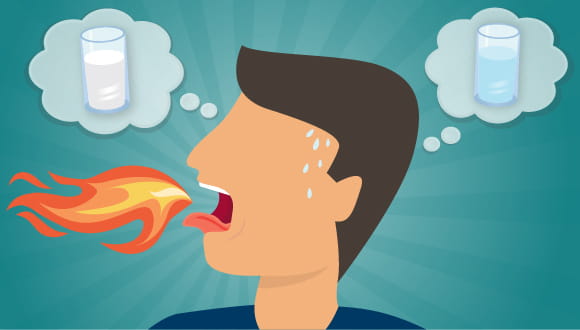So, you got a little overconfident and went with extra-hot buffalo sauce for your wings, added too many jalapenos to your nachos or were way too generous with the cayenne pepper while cooking dinner. Or maybe you just had no idea those peanuts were even going to be spicy.
Whether on purpose or not, we've probably all bit off more than we could chew, at least a time or two, when it comes to spicy foods.
So is there anything you can do to help cool down your mouth after eating spicy food? Or was your fate sealed with that first bite?
As it turns out, soothing that fire in your mouth starts with understanding the science behind the burn — since it can help you understand what to reach for (and what to avoid) as soon as that burn hits.
What spicy food does to your body
You already know that when your mouth is on fire, it's not really on fire. It just feels like it is. But why?
While the two may seem unrelated, the burning sensation you feel when eating something spicy is similar to the burning pain you experience when you accidentally touch a hot pan. In response to each, temperature-sensitive pain receptors are triggered — immediately screaming, "This is HOT!" to your brain.
Sensing your skin or mouth is in danger, your brain sends back sensations of pain, hoping to encourage you to stop doing whatever it is you're doing.
In the case of the hot pan, this pain serves an important purpose — it triggers an immediate reflex to remove your hand before it burns.
In the case of a hot pepper that's not even actually hot, so to speak, the reason is less obvious.
Hot peppers contain an alkaline, oil-based molecule called capsaicin, which sneakily triggers the temperature-sensitive pain receptors in your mouth even though the molecule itself doesn't produce heat or cause any real damage (unless you really overdo it).
Once capsaicin triggers these pain receptors, your brain is tricked into thinking your mouth is in danger — cue the burning pain meant to encourage you to stop eating whatever spicy thing you're eating.
These pain receptors in your mouth can adjust to the capsaicin's trickery, though. If you overstimulate these temperature-sensitive receptors by eating spicy food often enough, they're more likely to become desensitized to capsaicin. This is why people who eat spicy food frequently are able to handle it better than those who don't — the "burning pain" is dulled for them.
For those who don't eat spicy food often, the burning sensation is either too much, and you stop eating it altogether, or you try to dull the burn by reaching for something you think might help cool your mouth down.
What helps cool your mouth from spicy food?
So, you ate the hot wings, and now here you are: Frantically searching the internet for some sort of spicy food hack — literally anything to put out the fire spreading through your mouth and keep you from sweating bullets. (Related: Why We Sweat When We're Hot, as Well as When We're Not)
Armed with your new knowledge about the science of capsaicin, here are the do's and dont's of cooling your mouth down after eating spicy food:
DO reach for some dairy. Many milk-based products contain a protein called casein, which can help break down those capsaicin tricksters. Think of casein as a detergent — attracting, surrounding and helping wash away the oil-based capsaicin molecules floating around your mouth, similar to how soap washes away grease. The catch here is that the dairy product you choose must contain casein to have any chance of cooling your mouth down. Good examples of milk products that contain casein include cow's milk (not almond, coconut or soy milk), yogurt, cottage cheese or sour cream.
DO drink something acidic. For those who need or want to avoid dairy, don't fret! You've got an option, too: acid. Remember how we said capsaicin is an alkaline molecule? Balancing it with an acid can help neutralize the molecule's activity. This means drinking or eating something acidic — such as lemonade, limeade, orange juice or a tomato-based food item or drink — may also help cool your mouth down. (Milk is also acidic, by the way.)
DO down some carbs. Starches are filling for a few reasons, one of which being that they typically come with a lot of physical volume. The volume that a starchy food brings can also be advantageous while eating spicy foods since it can help act as a physical barrier between capsaicin and your mouth. To put some starch between this sneaky molecule and your pain receptors, try eating a piece of bread, some rice or a tortilla.
DON'T assume a glass of water will be your salvation. If you take nothing else away, leave with this: Because capsaicin is oil-based, drinking water will basically just spread this molecule around your mouth — setting off even more of your pain receptors. Oops! To help cool your mouth down, skip the glass of water and try one of the options above instead.
DON'T expect alcohol to dull the pain. You've seen the old war movies. Before closing an open wound, one soldier pours alcohol on the wound to disinfect it. The wounded soldier then chugs what's left in the flask. People have been using alcohol to dull pain for a long time. But, just know that the amount of alcohol it takes to effectively reduce pain way exceeds the guidelines for moderate alcohol use. Plus, a lot of alcoholic beverages are really more water than they are alcohol, and, well...see above.
Now that you know the do's and dont's of cooling your mouth down after eating spicy food, maybe you won't need to hold back on the jalapenos and cayenne pepper as often.













